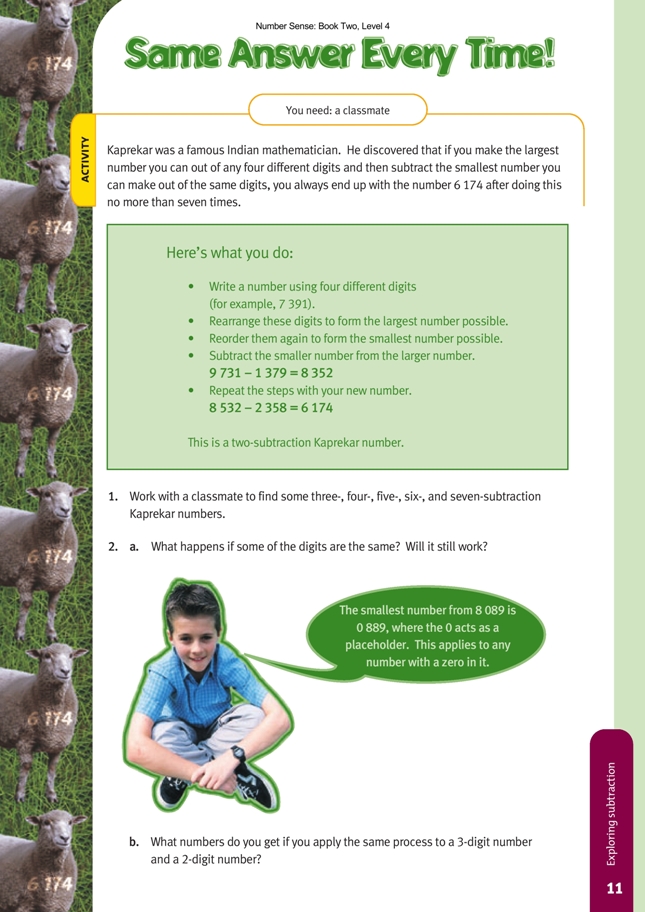This is a level 3 number activity from the Figure It Out series. It relates to Stage 6 of the Number Framework.
A PDF of the student activity is included.
Click on the image to enlarge it. Click again to close. Download PDF (624 KB)
solve subtraction problems
A classmate
This activity follows on quite nicely from that on palindromic numbers on page 8 of the student book.
The strategy that most students will use to work out solutions to question 1 is trial and error, which is entirely appropriate in this case. The results of the investigations by pairs of students could be shared with the whole class and demonstrated by the pairs to be valid. It might be worth keeping a class tally to see which number of subtraction steps is most common. Examples of three-subtraction through to seven-subtraction Kaprekar numbers are given in the Answers.
Question 2a is a good example of the kind of mathematical questioning that the mathematics curriculum document proposes students should develop. The example given, namely, 8 089, does in fact become a Kaprekar number after four subtraction steps. This holds for 4-digit numbers generally, with the exception of numbers such as 6 666, in which all the digits are the same. You could ask the students why it wouldn’t work with such numbers. A moment’s thought will probably have them saying that because the largest number is equal to the smallest number, the result of subtracting such numbers is always zero (6 666 – 6 666 = 0), so it gets you nowhere!
So far, the focus has been on 4-digit numbers. Question 2b raises the question of whether there is a similar pattern with 3-digit and 2-digit numbers. Again, this is the kind of questioning that the students should be encouraged to engage in and then follow up with an investigation, possibly in pairs.
The students may prefer to investigate 2-digit numbers before moving on to 3-digit numbers because they are simpler to investigate. For example, if one were to begin with 29, the first calculation would be 92 – 29 = 63, the second 63 – 36 = 27, the third 72 – 27 = 45, and the fourth 54 – 45 = 9. This could be taken further (for example, 90 – 9 = 81; 81 – 18 = 63), but the numbers begin repeating themselves.
The students have not been given the Kaprekar numbers in the 2- and 3-digit number cases, so they will not be sure when to stop the process. They will need to investigate several numbers before they arrive at the figures given in the Answers. Once again, it may be useful to keep a class record of Kaprekar numbers suggested by the students until the actual numbers become clear.
As an example of a 3-digit number, take 264. The first calculation would be 642 – 246 = 396, the second 963 – 369 = 594, and the third 954 – 459 = 495. At this point, the last numbers would keep repeating, so it seems that the Kaprekar number for 3-digit numbers is 495. However, here again the students would need to try other examples to check whether this is so.
After they have engaged in this investigation, maybe in pairs, you could invite them to raise any other related mathematical questions. For example, “Could it work with 5-digit numbers?” It appears from examples such as 23 641, 37 218, 69 875, 32 754, and 75 863 that the Kaprekar number is 74 943, whereas for some other 5-digit numbers, for example, 38 275 and 51 936, the Kaprekar number is 63 954.
The calculator comes into its own in this sort of investigation. It makes it possible to accurately investigate a series of numbers in a relatively short time.
Answers to Activity
1. Numbers will vary. Possible solutions (found through trial and error) include:
3 subtraction 4 123
4 subtraction 2 378
5 subtraction 9 854
6 subtraction 2 589
7 subtraction 3 261
(You may have noticed that the same numbers that are in the shorter subtractions eventually appear in the longer subtractions.)
2. a. Yes, it still works, except when all four digits are the same. (Note that a result of 999 is re-formed as 9990 – 0999.)
b. 3-digit numbers end up as 495, and 2-digit numbers end up as 9.
